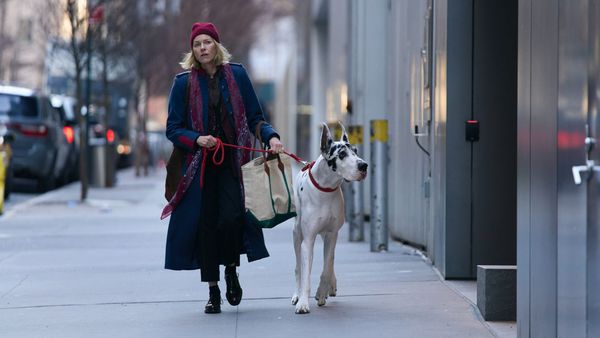Eye For Film >> Movies >> The Friend (2024) Film Review
The Friend
Reviewed by: Anne-Katrin Titze

David Siegel and Scott McGehee’s wondrous and sage The Friend (spiritedly adapted from the National Book Award winning novel by Sigrid Nunez and a highlight in the Spotlight programme of the 62nd New York Film Festival) stars Naomi Watts as Iris, an author in New York City who loses her best friend Walter (Bill Murray) to suicide and inherits his majestic Harlequin Great Dane Apollo (played by the scene- and heart-stealing Bing).
After already having thrown the advice by WC Fields to never work with children or animals to the wind with their beautiful Henry James adaptation What Maisie Knew, Siegel and McGehee fully embrace the tale of a friendship that belies our dominant anthropocentrism. “How can you explain death to a dog?” Iris, as well as the nameless narrator in the Nunez novel know some important truths about animals: “They don’t commit suicide. They don’t weep. But they can and do fall to pieces. They can and do have their hearts broken. They can and do lose their minds.”

Nunez also has another one of her novels, What Are You Going Through, adapted by Pedro Almodóvar for his The Room Next Door (Golden Lion winner at the Venice International Film Festival and the NYFF Centerpiece Gala selection highlight) coming to us at the same time. It stars Tilda Swinton and Julianne Moore and also celebrates the beauty of the city and the potency of friendship.
One remarkable contrast between the two films, which makes us see the characters in a different light, is the choice of clothing for the female protagonists. The Friend’s costumes by Stacey Battat (who did What Maisie Knew and is a Sofia Coppola mainstay - Priscilla, Somewhere, The Beguiled, The Bling Ring, plus Wash Westmoreland and Richard Glatzer’s Still Alice) present a woman with eclectically practical taste and a penchant for layers of cardigans and wildly patterned tops under tweed jackets and scarves. Where Almodóvar lifts his leading ladies to a painterly realm in their fashions (costume design by Bina Daigeler), Iris remains down to earth and her gigantic brown leather bag seems to already foreshadow the largesse of the animal companion to come.
Iris’s Manhattan apartment doesn’t allow dogs (she was used to having cats) but as both she and Apollo are deeply mourning, a way forward will present itself. She hopes. Neither Walter’s widow (Noma Dumezweni), nor his two ex-wives (Carla Gugino and Constance Wu), nor his daughter (Sarah Pidgeon) - all present at his wake and a scattering of the ashes on a boat on the East River - have the stamina or temperament to care for this very large animal, but Iris engages with him staunchly and completely.
“You will see a large chest, standing in the middle of the floor, and upon it a dog seated, with a pair of eyes as large as teacups. But you need not be at all afraid of him.” As in Hans Christian Andersen’s tale The Tinderbox, Iris has to conquer her own fears. She knows how her whole self is at stake when dealing with this big, sad, lovable being who himself has to overcome so much.
A novel and a movie are two very different creatures and so the Anderson quote, placed as epigraph in the book, here turns into a dinner conversation about the violent aspects of the tale. Music replaces some of the excursions into other works of art. Bill Murray’s Walter, while out running, pants along the promenade under the Brooklyn Bridge to The Magic Flute, later on Mozart’s Don Giovanni and some Christmas songs are supposed to calm Apollo, who doesn’t like to be left alone at home.
There is even a brief canine Midnight Cowboy homage hidden to enjoy. Blossom Dearie’s version of I’ll take Manhattan will be the sendoff song over the end credits, a superb choice for a very New York film. Apollo loves the written word, he loves being read to. In the novel it is Rilke, a choice I found so wonderful that it didn’t even dawn on me at first that he might be named after his Archaic Torso of Apollo, the poem that ends so devastatingly in the urgent appeal to change one’s life.
For a neighbor’s (Ann Dowd) holiday party with obligatory headgear, Iris dons what looks like part Statue of Liberty, part variant of a Swedish Santa Lucia with mini disco balls in her crown. The patron saint of the blind and symbol of welcome are both woven into her being. She is the emotional support human to Apollo, as she tells a doubtful therapist (played by Tom McCarthy, the director of the multiple Oscar-winning film Spotlight).
The subject of writing fiction, the work of mourning, and the often serpentine relationship between animals and humans are brilliantly intertwined and culminate in a surprising twist in the novel. Siegel and McGehee create their own take on the shift in narrative, keeping the mystery and the dachshund, while adding a fidgety Bill Murray, whose Walter, unable to find the right spot for the daffodils in his hands, paces the rooms like a ghost.
Reviewed on: 18 Oct 2024














